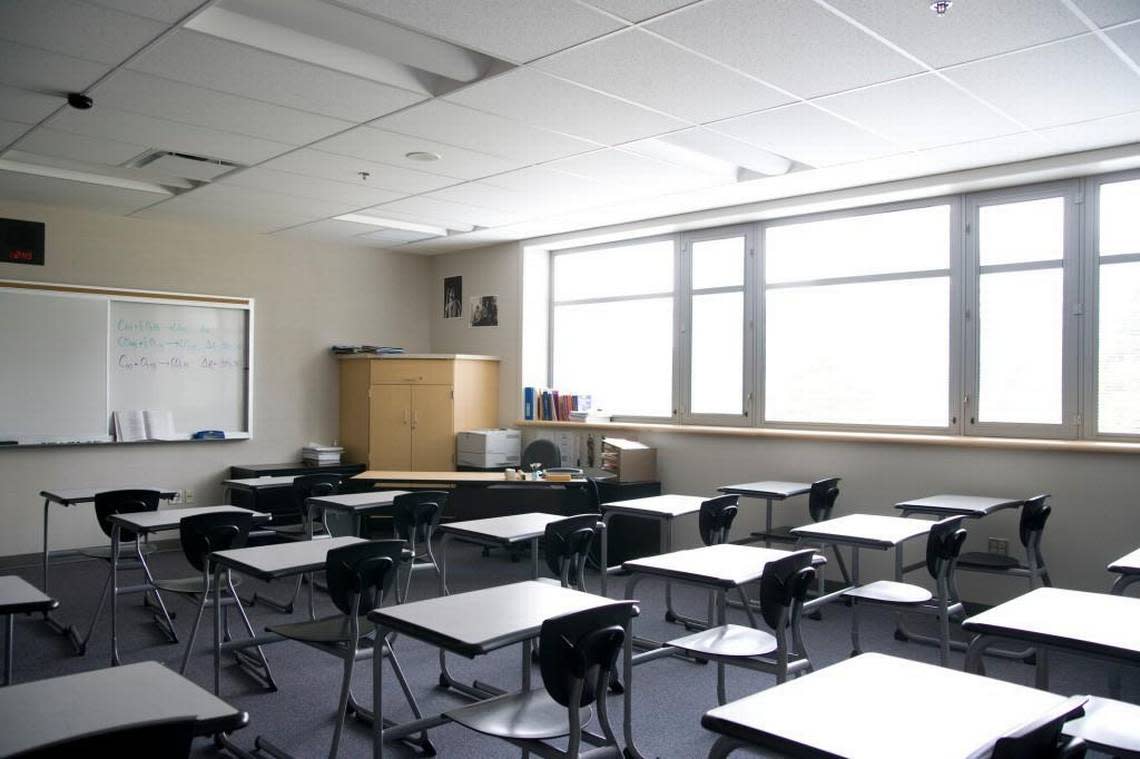Which Wichita schools could close? Data shows these buildings may be at risk

Between four and seven Wichita schools are expected to close for good at the end of the semester.
The school board faces tough decisions as the district grapples with lagging enrollment and more than $1 billion in deferred maintenance needs.
An Eagle analysis has identified some elementary and middle schools that may be at risk of closure based on enrollment level and building condition.
The district has indicated staffing levels and building location will also be factored into the recommendations brought before the board on Feb. 12. No high schools will be affected.
The BOE last voted to close three elementary schools in 2012, when Bryant, Emerson and Lincoln were shuttered and Isely and Mueller magnet schools were relocated.
Building condition
Eighteen of Wichita’s 54 elementary schools have a facility condition index (FCI) of 0.65 or higher — indicating poor condition — as do eight of the city’s 15 middle schools.
FCI is a metric used to assess deferred maintenance needs and calculate the value of reinvesting in a building versus replacing it. The score ranges from 0 (pristine condition) to 1 (extremely poor condition).
Among elementary schools, Park (0.95) and Adams (0.90) are in the worst condition, followed by Riverside Magnet (0.84), the oldest elementary building, which was constructed in 1910.
Many of Wichita’s middle schools are clustered together in similar condition. Mayberry Magnet (0.82) has the worst rating of any middle school, with six others — Curtis, Robinson, Hamilton, Marshall, Allison Magnet and Mead — ranging from 0.76 to 0.80.
Enrollment
Wichita Public Schools enrollment has declined by nearly 9% since 2016, and many of the students who left the district early on in the pandemic haven’t returned.
Elementary schools in particular have suffered from depressed enrollment in recent years, with records showing 24 of 54 buildings have fewer than 350 students this school year.
The elementary schools with the lowest enrollment are Payne (231 students), Riverside Magnet (233), L’Ouverture Magnet (234), Clark (240) and Hyde Magnet (258).
The district also keeps track of building utilization, meaning what percentage of full capacity each school operates at.
Smaller schools like Hyde and Riverside are operating at 89% and 83% capacity, respectively, while Payne is using 59% of its space, L’Ouverture Magnet 58% and Clark 51%. Jackson’s 46% utilization (290 students) is the lowest of any elementary building, but it’s also one of the district’s newest, constructed in 2004.
Cooperative Strategies, the Ohio-based consulting firm hired by the school board to assess facilities needs, has said target utilization should be between 85% and 95%.
On the middle school side, 11 of 15 buildings enrolled between 500 and 600 students this school year. The lowest enrollment is at Jardine (500 students), followed by Mead (502), Marshall (505), Hadley (507) and Brooks Magnet (529).
Jardine’s utilization rate of 71% is actually among the highest for middle schools while Brooks (59%) and Hadley (51%) are among the lowest.
Vulnerable elementary schools
Thirteen Wichita elementary schools have fewer than 350 students enrolled and an FCI score of 0.65 or higher.
Park - 0.95 FCI, 337 students, 74% utilization, built in 1922
Riverside Magnet - 0.84 FCI, 233 students, 83% utilization, built in 1910
Pleasant Valley - 0.80 FCI, 275 students (-29 students), 62% utilization, built in 1948
Clark - 0.76 FCI, 240 students, 51% utilization, built in 1952
OK - 0.75 FCI, 276 students, 67% utilization, built in 1929
Franklin - 0.75 FCI, 309 students, 84% utilization, built in 1941
Irving - 0.75 FCI, 321 students, 66% utilization, built in 1941
Peterson - 0.71 FCI, 327 students, 62% utilization, built in 1932
Payne - 0.70 FCI, 231 students, 59% utilization, built in 1953
Black Magnet - 0.70 FCI, 280 students, 59% utilization, built in 1954
Hyde Magnet - 0.67 FCI, 258 students, 89% utilization, built in 1930
McCollom - 0.65 FCI, 311 students, 62% utilization, built in 1959
Harry Street - 0.65 FCI, 318 students, 86% utilization, built in 1922
Of those 13 elementary buildings, seven also have a utilization rate of less than two-thirds — Clark, Black Magnet, Payne, McCollom, Peterson, Pleasant Valley, and Irving.
Others, like Adams, are vulnerable based on a single metric. Despite middle-of-the-pack enrollment (377) and above average utilization (79%), Adams has the second worst FCI score in the district (0.90).
L’Ouverture Magnet has one of the lowest enrollments (234) and building utilization rates (58%) but the building is in slightly better condition than others (0.62 FCI).
Vulnerable middle schools
Minimal variation in enrollment and building conditions make it somewhat more difficult to assess which middle school or schools could be in danger of being shuttered.
Jardine, which has the lowest enrollment (500), is at 71% utilization and has a comparatively low FCI of 0.55.
Coleman has the lowest utilization (49%) and relatively few students (544). But for an almost 60-year-old building, it’s in surprisingly good condition (0.35 FCI).
Robinson has the second worst building condition (0.80 FCI) but its enrollment (693) and utilization (70%) are among the highest in the district.
Of the Wichita middle schools with an FCI above 0.65, six also have sub-600-student enrollment and/or utilization rates below two-thirds.
Mayberry Magnet - 0.82 FCI, 596 students, 74% utilization, built in 1954
Curtis - 0.80 FCI, 774 students, 58% utilization, built in 1951
Hamilton - 0.78 FCI, 552 students, 66% utilization, built in 1918
Marshall - 0.78 FCI, 505 students, 68% utilization, built in 1939
Allison Magnet - 0.77 FCI, 535 students, 67% utilization, built in 1919
Mead - 0.76 FCI, 502 students, 61% utilization, built in 1951
Contributing: Amy Renee Leiker of The Eagle


